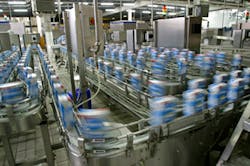OEE Solutions Provide the 'Why' and 'How' to Improved Plant Performance
One of the common improvement measures manufacturers use to affect performance changes is Overall Equipment Effectiveness (OEE). Simply put, OEE pits overall plant capability against actual performance; it’s established by determining overall capacity and planned production time, and then calculating loss due to downtime (availability), speed loss (performance), or throughput loss (quality).
But the bottom-line is that “you can’t improve what you can’t measure,” says Le Roy Howe, Technical Consultant, Information Solutions, Rockwell Automation. Even the simplest metrics implementation can provide guidance to operators seeking an indication of how a line is running today vs. yesterday or last week—delivering real results to the plant’s balance sheet.
While determining what’s breaking down on a single machine is a good first step, scaling such a system up to work in concert with other manufacturing software does significantly more to improve overall plant performance. Doing so first requires accurate data; next, it requires a systematic approach to organizing—and then reporting—on that data. That systematic approach turns a collection of data points into relevant, actionable manufacturing intelligence.
Once you know you have accurate information, in some respects, simply calculating OEE can be viewed as reaching for low-hanging fruit. It is a universal measurement that is applicable to any machine, in any plant, in any industry. What’s more difficult is to determine (and correct) is the impact of that information.
Todd Smith, Product Manager, Rockwell Automation, likens a raw calculation of OEE to taking a test, getting a grade, but never seeing which answers you got right, and which you got wrong.
With FactoryTalk Metrics from Rockwell Automation, users gain real plant-floor production reporting (on factors like machine-state) from a workcell all the way up to site data. This information can then be used to make better decisions about optimizing asset utilization. That improvement may come from any of the three dimensions of OEE: taking less time during the production process (performance), reducing material waste (quality) or reducing cycle time (availability), for example.
Howe has been sampling Metrics’ capabilities in the field for customers. He brings the technology into a plant, quickly configures it to a line, and lets in run for a couple of hours.
“When I come back and show the plant managers and operators the reports that we generated in that short amount of time, it’s a real transformation for them. With very low implementation cost and very quick configuration and set up, we can provide proof-of-concept in 4 hours.”
No doubt, the effective measurements capabilities provided by FactoryTalk Metrics undergird a sound manufacturing intelligence strategy. But metrics alone are only the baseline; information reaches its real potential when it is given context, with an enabling technology like FactoryTalk VantagePoint. VantagePoint combines data from a variety of sources within the plant through a Unified Production Model (UPM) that organizes and reports on that information.
So, if Metrics records that a machine is experiencing significant downtime, VantagePoint can take process information on temperature or viscosity from a Historian, for example, and identify a pattern or relationship between downtime and those conditions. Or, with information on material costs pulled from an ERP system, help a plant manager to understand how much downtime or scrap actually costs.
“If you are able to contextualize your data, then you have a method for discovering the relationship between pieces of equipment and their impact on business results,” says Keith Chambers, MES Software, Business Manager, Rockwell Automation.
SIDEBAR:
A North American food and beverage plant experienced this insight firsthand as it tried to determine the cause of maintenance-based downtime occurring on their line. The FT Metrics installation began reporting frequent stops or stalls during a shrink-wrap operation. The plant manager said FT Metrics must be wrong—they simply were NOT experiencing day-to-day downtime on that line.
It turned out that, undetectable to the human eye, the shrink-wrap operation was blinking on and off—just so rapidly it wasn’t causing any downstream slowdown. Using the automated data collection of Metrics enabled operators to see that machines were cycling on and off and adjust maintenance schedules accordingly.
“Sometimes you don’t know you have a problem until you can observe the process,” said Le Roy Howe, Technology Consultant, Rockwell Automation. “The problems and their solutions might be different with every manufacturer, but the ability to get a window into the ‘how’ and ‘why’ is the key starting point for solving them.”
For more information, visit http://discover.rockwellautomation.com/mi

